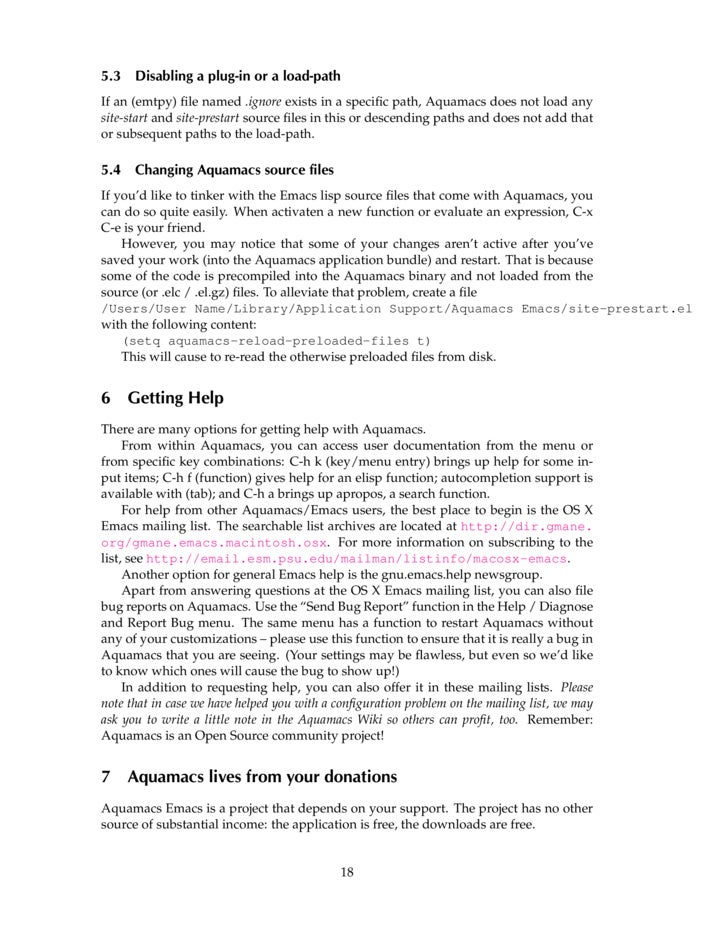
- #AQUAMACS TUTORIAL FOR MAC OS X#
- #AQUAMACS TUTORIAL INSTALL#
- #AQUAMACS TUTORIAL PATCH#
- #AQUAMACS TUTORIAL FREE#
AquamacsĪquamacs is a heavily patched fork of GNU Emacs.

Also, if I remember correctly, the author of this patchset has shown little interest to bring the features back upstream, probably for the former reason.
#AQUAMACS TUTORIAL FREE#
Some of its features make their way back into GNU Emacs, but other will never be merged, since they are exclusive to OS X, and not available in the free alternative GNUStep, which goes against the politics of the FSF to not support proprietary operating systems over their free alternatives. Other than that, Emacs Mac Port is pretty much like a standard GNU Emacs.

You'll notice that most of these features are merely concerned with integration into OS X, and are not essential to using Emacs. Webkit has better SVG support to my knowledge, but who views SVGs in Emacs? Native SVG display using Webkit, rather than librsvg.You can open a selected file in Finder from the context menu in the running Emacs. Three-finger tapping will search the word under cursor in Apple's Dictionary application, like in other OS X applications. You can send and receive Apple Events from Emacs Lisp. Again, if you don't use the mouse, you won't notice it, and it's arguably just a fancy feature. You can pinch to increase/decrease the text size. It only affects trackpad scrolling, though, so if you don't use the mouse, you won't need it. Emacs Mac Port uses pixel-based scrolling like other native OS X applications, which feels much smoother and is much more precise. GNU Emacs proper scrolls line-wise, which is very laggy and jumpy with trackpads. This was merged into GNU Emacs proper, and is part of Emacs 24.4. Core Text for text rendering, which improves text appearance and Unicode support.
#AQUAMACS TUTORIAL PATCH#
Note that GNU Emacs itself has native OS X support as well, but lacks the OS X specific additions, which this patch set provides. Emacs Mac PortĮmacs Mac Port is a patch set for GNU Emacs proper for better OS X integration. The other distributions are patched and forked variants of GNU Emacs.

This is the only distribution which you can create yourself in GNU Emacs proper by installing additional Emacs packages and adjusting your init.el accordingly.
#AQUAMACS TUTORIAL INSTALL#
The choice of packages suggests that it's mostly targeted at statistician and researches, which would work through their data with R and ESS, and then publish a paper with Org or AUCTeX and LaTeX.įor other users, this distribution is probably of little value, since you'd need to install additional packages anyway, and might as well use GNU Emacs proper right away. For instance, you can install AUCTeX in GNU Emacs proper by simply typing M-x package-install RET auctex, and enabling it. With the notable exception of ESS, all of these packages are available through Emacs' package archives for installation in any Emacs.

Emacs for OS X ModifiedĪccording to the website Emacs for OS X Modified is simply a standard build of GNU Emacs, based on the above, with some additional packages, and the necessary configuration to enable all of these packages. If you'd like to use these-the former is particularly important if you'd like to read your mail in Emacs-you need to get GNU Emacs from Homebrew. Note though, that these binaries lack support for some libraries, notably GNU TLS and ImageMagick. All of these builds are self-contained, which lets you safely try pretests and snapshots. The site provides builds of stable releases and pretests, as well as nightly snapshots. It's roughly the same you'd get by compiling a GNU Emacs release tarball with.
#AQUAMACS TUTORIAL FOR MAC OS X#
Emacs for Mac OS X provides OS X binaries of GNUĮmacs proper.


 0 kommentar(er)
0 kommentar(er)
